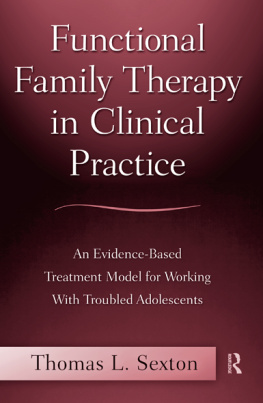Contents

Copyright 2006 by John Wiley & Sons, Inc. All rights reserved.
Published by John Wiley & Sons, Inc., Hoboken, New Jersey.
Published simultaneously in Canada.
No part of this publication may be reproduced, stored in a retrieval system, or transmitted in any form or by any means, electronic, mechanical, photocopying, recording, scanning, or otherwise, except as permitted under Section 107 or 108 of the 1976 United States Copyright Act, without either the prior written permission of the Publisher, or authorization through payment of the appropriate per-copy fee to the Copyright Clearance Center, Inc., 222 Rosewood Drive, Danvers, MA 01923, (978) 750-8400, fax (978) 646-8600, or on the web at www.copyright.com . Requests to the Publisher for permission should be addressed to the Permissions Department, John Wiley & Sons, Inc., 111 River Street, Hoboken, NJ 07030, (201) 748-6011, fax (201) 748-6008, or online at http://www.wiley.com/go/permissions .
Limit of Liability/Disclaimer of Warranty: While the publisher and author have used their best efforts in preparing this book, they make no representations or warranties with respect to the accuracy or completeness of the contents of this book and specifically disclaim any implied warranties of merchantability or fitness for a particular purpose. No warranty may be created or extended by sales representatives or written sales materials. The advice and strategies contained herein may not be suitable for your situation. You should consult with a professional where appropriate. Neither the publisher nor author shall be liable for any loss of profit or any other commercial damages, including but not limited to special, incidental, consequential, or other damages.
This publication is designed to provide accurate and authoritative information in regard to the subject matter covered. It is sold with the understanding that the publisher is not engaged in rendering professional services. If legal, accounting, medical, psychological, or any other expert assistance is required, the services of a competent professional person should be sought.
Designations used by companies to distinguish their products are often claimed as trademarks. In all instances where John Wiley & Sons, Inc. is aware of a claim, the product names appear in initial capital or all capital letters. Readers, however, should contact the appropriate companies for more complete information regarding trademarks and registration.
For general information on our other products and services please contact our Customer Care Department within the United States at (800) 762-2974, outside the United States at (317) 572-3993 or fax (317) 572-4002.
Wiley also publishes its books in a variety of electronic formats. Some content that appears in print may not be available in electronic books. For more information about Wiley products, visit our web site at www.wiley.com .
Library of Congress Cataloging-in-Publication Data:
Shapiro, Jeremy P.
Child and adolescent therapy : science and art / by Jeremy P. Shapiro, Robert D. Friedberg, Karen K. Bardenstein.
p. cm.
Includes bibliographical references.
ISBN-13 978-0-471-38637-7 (cloth)
ISBN-10 0-471-38637-5 (cloth)
1. Child psychotheraphy. 2. Adolescent psychotherapy. I. Friedberg, Robert D., 1955 II. Bardenstein, Karen K. III. Title.
RJ504.S516 2005
618.928914dc
2005047032
Preface
Preface The Therapists Challenge
The purpose of this book is to equip readers with the skills and knowledge they need to provide effective psychotherapy to children and adolescents. We aim to provide an understanding of the major theoretical approaches, knowledge about the findings of outcome research, a feeling for what counseling is like, and training in a variety of therapeutic techniques. This is an academic text and, also, a how-to book. We view intellectual rigor and practical application as equally important and complementary objectives. Thus, the book is about theory, etiology, change agents, technique, meta-analysisand what to say to the client.
The Diagnostic and Statistical Manual of Mental Disorders, Fourth Edition, Text Revision ( DSM-IV-TR; American Psychiatric Association, 2000) defines mental disorders as behavioral or psychological syndromes involving either significant distress (e.g., symptoms such as anxiety and depression) or significant functional impairment in life areas such as work, school, relationships, and compliance with social norms. Mental health problems involve behavior, emotions, relationships, and the cognitions and skills involved in these dimensions of functioning. Developmental issues are often important considerations in the diagnosis and treatment of young people.
Emotional and behavioral problems are not uncommon in youth. Approximately one child in five has a significant mental health problem (U.S. Public Health Service, 2001). This prevalence rate is quite consistent across a range of countries and cultures (World Health Organization, 2001). However, most youth who need treatment do not receive it; in the United States, only 6% of young peopleless than one-third of those who need servicesreceive mental health care each year (Sturm et al., 2000).
Weisz (2004, p. 5) defined psychotherapy as, an array of nonmedical interventions designed to relieve psychological distress, reduce maladaptive behavior, or enhance adaptive functioning through counseling, structured or unstructured interactions, training programs, or specific environmental changes. The common element linking these activities is this: Psychotherapy relies on talking as a method of ameliorating problems. Therapy is not alone in its purposeful use of conversation, and people have sought help by talking to trusted relatives, friends, and clergy for far longer than counseling has existed. But therapy is also a professional service and, to justify the remuneration they receive, counselors should be able to provide forms of help that laypeople cannot reliably offer. There needs to be something different about our talk.
Therapy fulfills a distinctive and rather remarkable function in our society. When something goes wrong with our cars, we go to automobile mechanics to fix the problem. When something goes wrong with our bodies, we go to physicians for treatment. When something goes wrong with our emotions or behavior, society recognizes psychotherapists as the people to call for help with these central aspects of self.
Given the deeply personal nature of the problems for which counseling is sought, clients and parents are in a position involving considerable vulnerability and trust. They are generally willing, just moments after meeting a stranger, to describe important, painful, and, perhaps, embarrassing aspects of their lives. Therapy is about issues that people do not usually discuss with full openness, such as love, rejection, anger, sex, happiness, unhappiness, and so forth. Clients and parents may be willing to disclose information and feelings they have never told anyone before just because the stranger sitting in front of them has a license indicating her commitment and ability to respond helpfully to this type of disclosure.
The trust that parents demonstrate by bringing their children to therapists imposes an important responsibility on these professionals. This responsibility may result in a feeling of pressure, which can be beneficial if it impels us to do our best for clients. It is an honor and a privilege to work with people on the deepest, most personal aspects of their lives and, in order to be worthy of this trust, we must do our best not to let our clients down.









